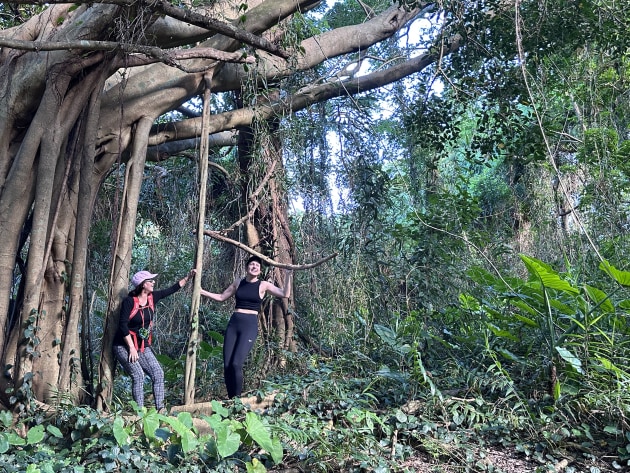In part one of our two-part story, Great Walks spends a week on Okinawa exploring this extraordinary Japanese island on foot.
Things are done a little differently in Okinawa. People are a little different too. ‘We are quite unlike the rest of Japan down here,’ they’ll tell you. ‘Our landscapes, our culture, our food, is really quite different to the rest of Japan,’ they’ll say.
Walking too is a little different in Okinawa, one of 160 islands in the prefecture, some 1,600km south of bustling Tokyo. Trails are less formal than the designated hikes in the country’s north.

At the heart of Japan’s health food-focused Blue Zone, it’s not uncommon for Okinawans to live to 100 years of age thanks to their predominantly vegetarian/pescetarian diet. It’s also not uncommon to take walks with owners of off-the-trodden-track lodgings and rural restaurants. Call it walking in their shoes.
At Kunigami, in the UNESCO World Natural Heritage area of Yambaru in northern Okinawa, is Yambaru Hotel Nammei Shinshitsu. Sister owners, Itsumi and Yu Nakamoto, offer what they call a ‘village adventure residence’. Led from wooden villa accommodation, sherpa-style interpretive walks immerse guests into the ordered village of Jashiki. Population: 28.

The cultural walk penetrates maze-like alleyways bordered by towering hedgerows of Fukuji (garcinia) trees, between which, native black Agu pigs dart. The mysterious amble meets with Ishiganto (small stone plaques), mounted discreetly but strategically on right-angled street corners. They are designed to derail evil spirits (that only move in a straight line) from entering homes.
Visitors are invited to pause at a modest shrine where deities of village ancestors are worshipped. While Okinawa is not religious per se, it embraces connection to the natural world, more in keeping with animism’s reverence of animals, rivers, trees, rocks and mountains.
The tour culminates at traditional guest villas, within which, Michiko (the sisters’ mother) cooks a vegetarian evening meal, sharing stories from the village. The following evening, a certified Hai-kei Meister arrives to barbecue soul food over charcoal. It is a culinary tradition at Jashiki village to cook an aged chicken that no longer lays eggs. The flavour makes up for the toughness of the old bird.

In Kin Town, at the island’s heart, Ritsuko Tomimori, a naturalist guide from Okinawa Nature Office, along with bird expert, Kenji Takehara, leads walks between two significant heritage springs.
The cultural heritage site of Ukkagaa Spring is known as the Fountain of Longevity. Historically, locals relied on its mountain-fed Ryukyu limestone-filtered waters for bathing, laundry and cooking. Now protected, the spring pumps 1000 tonnes of water through its spouts per day.
A 30-minute walk along the edge of town towards the Okukubi River leads to where the life-giving waters head. Along the way, kuroki trees are pointed out. Their hardwood is crafted into sanshins (Okinawa’s fretless three-stringed banjo).

Kintaga Spring (perhaps more visited by freshwater shrimp than people) is located by Kin Town’s life-giving taamu plantations. Taamu (Okinawa’s sticky and sweet version of taro) makes its way onto plates at Kin Town’s Choraku restaurant where Yoshiki Toyokawa prepares inventive taro dishes, including a taro cheesecake.
An amble alongside verdant paddies allows Kenji to identify migratory birds. Commonly spotted residents include the black-crowned night heron and cinnamon bittern. To date, Kin Town has recorded sightings of 270 species of feathered friends.
Gajimanro Café at Ogimi sits cloaked in by forest. The owner of the family-run restaurant, Emiko, invites hungry hikers into her floral food gardens (often from beneath an equally floriated parasol). Supersized mormon butterflies also feast here, on nectar from colossal red pagoda flowers. Emiko walks diners through vast herb patches to pick Okinawan mugwort that joins their plate. The endemic herb is believed to be one of the secrets to Okinawan longevity.

Then it’s a short walk to Emiko’s orchard for Shikuwasa picking. Okinawa’s green-skinned native citrus fruit grows in mountainous limestone terrain, offering a flavonoid-rich flesh that is also believed to contribute to the longevity of the islanders. Emiko turns it into juices, salad dressing and jams.
From here, hikers can continue (self-guided) 1km uphill along a sealed road to Igimihaginzo lookout, deep inside UNESCO World Heritage-listed Yambaru National Park. From within Japan’s largest evergreen subtropical forest, sightings of the Ryukyu robin can be enjoyed.

A further 2.5km through forest shrilling with cicadas, and where many a buzzard flies and spies, lands you at Ishiyama Observatory. The lookout reveals stone sculptures and concrete picnic tables. Beyond the low stone wall, vistas sprawl along the Higashi coastline and across the East China Sea. Your only company up here is likely to be the two wind turbines whirring above you.
Read part two here and for more info on exploring Japan click here.
Words and photos_Marie Barbieri



